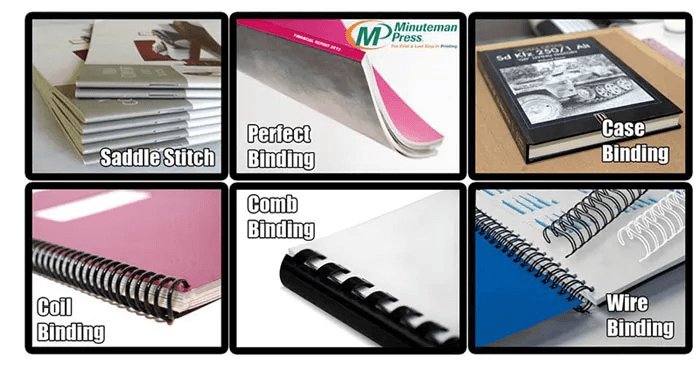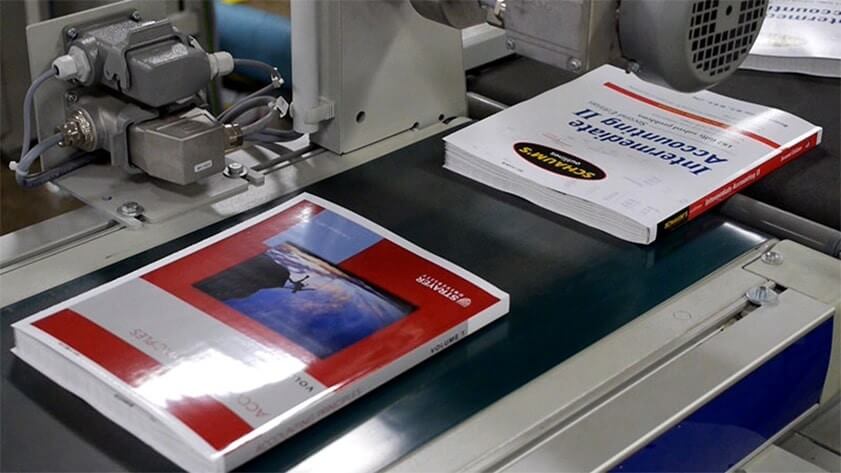Binding printing is where pages become stories, and ideas find their form.
In the vast universe of book printing and binding, where words and images are converted into tangible forms, there is a critical procedure that sometimes goes unnoticed but significantly impacts the finished product: binding printing. Beyond ink and paper, binding printing entails precisely combining printed sheets into coherent texts, booklets, or promotional materials. Throughout this lengthy research, we learned about the evolution, types, techniques, applications, and significance of binding printing and its varied role in changing the worlds of publishing, marketing, education, and corporate communication.
The origins of binding printing can be traced back to ancient civilisations, where scribes meticulously handcrafted scrolls, laying the foundation for bound documents. In the 15th century, Johannes Gutenberg pioneered the use of moveable type and the printing press, revolutionising information dissemination and paving the path for modern binding processes. Over the years, technological improvements, materials, and artistry have resulted in various binding methods, each with its qualities and purposes.
In-depth Exploration of Binding Techniques:
Saddle Stitching:
- Saddle stitching is a popular and affordable binding method. Printed sheets are folded in half and stapled along the fold.
- Suitable for pamphlets, brochures, newsletters, and periodicals with a low page count.
- It produces a clean and professional finish, although it may not be appropriate for papers with a large page count or thick paper stock.
Perfect Binding:
- Perfect binding is glossy and sophisticated, making it suitable for paperback books, catalogues, manuals, and heavy magazines.
- The spines of individual pages are glued to a wraparound cover, resulting in a seamless and sturdy binding.
- Allows for spine printing, which improves visibility and shelf appeal.
Spiral Binding:
- Spiral or coil binding involves inserting plastic or metal coils through punched holes along the document’s edge.
- It provides flexibility by enabling the paper to lie flat when opened, making it ideal for notebooks, planners, and instructional manuals.
- Available in various colours and sizes to suit different aesthetic preferences.
Wire-o Binding:
- Wire-O binding uses double-loop wires strung through punched holes in the pages to create a durable and professional binding solution.
- Suitable for calendars, reports, presentations, and reference documents that require frequent page turning and durability.
- Pages may be easily removed and inserted, allowing you to update or revise your material.
Case Binding:
- Case binding, also known as hardcover binding, is attaching printed pages to a solid cover, usually made of cardboard or fabric.
- It provides durability, protection, and a premium appearance, ideal for high-end books, journals, and commemorative editions.
- Requires specialised equipment and artistry, which raises the production cost while increasing the perceived worth of the final product.
Techniques and Considerations for Book Printing and Binding:
Pagination and Imposition:
- Pagination and imposition are essential for organising material and assembling printed sheets into a cohesive book.
- Pagination entails numbering pages in the correct order, including front matter, body text, and back matter, to ensure logical progression and simple access across the book.
- Imposition is the arrangement of pages on a printed sheet to optimise paper usage and streamline the bookbinding process, thereby reducing waste and increasing efficiency.
- Proper pagination and imposition are critical for appropriate collation, alignment, and trimming throughout the bookbinding process, resulting in a professional and polished appearance.
Bleed and Margin:
- Bleed and margin concerns are crucial for producing a clean, professional-looking book printing and binding.
- Bleed is the extension of images or colours beyond the trimmed edge of a page, ensuring no white borders after cutting and, therefore, improving visual continuity across the book.
- Adequate margin space surrounding the content keeps crucial information from being clipped during the finishing process and increases readability, allowing for more comfortable handling and annotation.
- Incorporating bleed and margin requirements helps book printing and binding seem consistent and professional, regardless of the binding style.
Paper Selection and Weight:
- The type of paper used considerably impacts the finished book’s appearance, feel, and durability.
- Paperweight, texture, finish, and opacity should all be carefully evaluated regarding the intended application, audience, and budget.
- Heavier paper stocks improve perceived quality and longevity by giving a significant feel and reducing show-through, particularly for opaque and high-ink coverage applications in book printing.
- Coated or textured treatments improve the overall appearance of the book cover and pages by adding tactile appeal and visual intrigue. They also convey a sense of elegance and sophistication.
Binding Strength and Durability:
- Assessing binding strength and durability is critical for ensuring that books can resist the stresses of handling, shipping, and reading.
- Page count, paper weight, binding method, and usage environment impact the best binding solution for book printing and binding.
- Pull testing and accelerated ageing simulations assist in detecting potential vulnerabilities and verify that the book binding can endure repeated use and external pressures.
- Using a solid bookbinding process and high-quality adhesives or binding parts helps to ensure the endurance and reliability of the finished book product, instilling trust in its performance and usability.
Finishing Options and Enhancements:
- Finishing options and additions increase printed books’ visual impact and functional variety, improving their overall appeal and usability.
- Options like foil stamping, embossing, debossing, and spot UV coating add tactile and visual contrast to the book cover, increasing the perceived worth and prestige of the finished product.
- Laminating or varnishing surfaces offer a protective layer to the book cover and pages, increasing resilience and resistance to moisture, abrasion, and fading, thus ensuring longevity.
- Incorporating speciality finishes and embellishments enables customisation and personalisation of book printing and binding, ensuring that volumes stand out and resonate with their intended audience.
Consideration of Binding Method:
- Choosing the proper binding method for book printing and binding requires careful consideration of document size, page count, usage frequency, and budget limits.
- Each book binding method has advantages and considerations, ranging from the low cost of saddle stitching to the durability of perfect binding and the elegance of case binding.
- Lay-flat capabilities, ease of page turning, and compliance with design features all impact the choice of the best book binding method for a specific project or application.
- Consulting with a printing professional or bookbinder early in the design phase helps establish the best book-binding solution based on the project needs and intended outcome, guaranteeing a smooth and successful production process.
Applications of Binding Printing:
Publishing Industry:
- Book printing and binding is the foundation of the publishing industry, enabling the creation of books, periodicals, journals, and other printed goods.
- Different binding methods meet publishing needs, from low-cost saddle stitching for magazines and periodicals to high-end case binding for hardcover volumes and special editions.
- Publishers use binding printing techniques to improve their books’ visual appeal, durability, and marketability while also appealing to the preferences and expectations of their intended audience.
- Whether it’s a best-selling novel, an academic textbook, or a niche magazine, correct binding guarantees that the printed contents stand the test of time and provide an engaging reading experience.
Marketing and Advertising:
- Businesses use book printing and binding to generate adequate marketing collateral, such as brochures, flyers, product catalogues, and promotional pieces.
- The binding method and finishing options influence brand perception, messaging efficacy, and consumer engagement, all reflecting the brand’s identity and values.
- Professional binding improves the credibility and professionalism of marketing messages, making them more memorable and convincing to their intended audiences.
- Whether a corporate brochure showing products and services or a promotional catalogue emphasising seasonal deals, well-bound marketing materials make a lasting impression and increase brand exposure and revenue.
Education and Training:
- Educational institutions use binding printing to create various educational materials, such as textbooks, workbooks, course packs, and teaching resources.
- Durable and well-bound instructional resources help students, educators, and lifelong learners learn, reference, and retain knowledge more effectively.
- Binding styles like spiral binding and wire-O binding allow for frequent page-turning, note-taking, and collaborative learning activities, improving the educational experience in traditional and online schools.
- Properly bound educational materials, whether a thorough textbook, a hands-on laboratory manual, or a multimedia course pack, help to ensure effective teaching and learning outcomes.
Corporate Communication and Documentation:
- Corporations use book printing and binding to create corporate documents, such as reports, presentations, proposals, policy manuals, and staff handbooks.
- Professional binding enhances the polish, professionalism, and brand consistency of corporate materials, strengthening the organisation’s identity and message.
- Whether an annual report highlighting financial performance and strategic plans or a business proposal providing project specifics and deliverables, professionally bound corporate papers capture attention, build confidence, and allow successful communication with stakeholders.
- Binding printing also applies to internal communications such as training manuals, policy documents, and employee guidelines, assuring clarity, consistency, and compliance throughout the organisation.
Personal and Specialized Applications:
- Binding printing is helpful for various personal and specialised applications, such as photo albums, scrapbooks, wedding albums, and commemorative books.
- Individuals and families may preserve treasured memories and milestones by making custom-bound picture books and albums that feature photographs, souvenirs, and personal narratives.
- Professional book printing and binding improve the aesthetic appeal, durability, and usability of specialised applications such as art books, trip journals, recipe collections, and hobby manuals.
- Binding printing transforms ordinary materials into beloved treasures and heirlooms, whether a handcrafted recipe book passed down through generations or a professionally printed trip notebook chronicling adventures worldwide.
Legal and Government Documents:
- Binding printing is essential for creating legal and government documents such as contracts, agreements, ordinances, and legislative reports.
- Legal papers must be bound securely and tamper-evidently to maintain authenticity, confidentiality, and legal compliance.
- Government agencies use binding printing to publish official reports, regulations, and policy papers, ensuring transparency and accountability for citizens and stakeholders.
- Properly bound legal and government papers make recording, archiving, and retrieval more accessible, aiding the administration of justice, governance, and public service delivery.
Healthcare and Medical Documentation:
- Binding printing is vital in the healthcare industry for producing medical documentation such as patient records, medical charts, and clinical recommendations.
- Secure and long-lasting binding procedures preserve the integrity and confidentiality of sensitive medical information, protecting patient privacy and complying with regulatory standards.
- Hospital facilities use book printing and binding to create instructional items like patient education booklets, hospital directories, and procedural manuals, which improve communication and interaction with patients and caregivers.
- Properly bound medical paperwork facilitates efficient healthcare delivery, accurate diagnosis, treatment planning, and continuity of care, all contributing to improved patient outcomes and healthcare quality.
Manufacturing and Technical Documentation:
- Binding printing creates technical documentation in the manufacturing industry, including product manuals, assembly instructions, maintenance guides, and safety standards.
- Explicit and well-bound technical documentation guarantees that end users, technicians, and operators have accurate and usable product setup, operation, and maintenance information.
- Binding printing techniques such as spiral binding and wire-O binding make it easier to reference and turn pages, allowing for more rapid troubleshooting and issue-solving in production contexts.
- Properly bound technical documentation promotes product quality, safety compliance, and user pleasure by reducing downtime, errors, and warranty claims while improving the customer experience.
Nonprofit and Community Organizations:
- Nonprofits and community groups use book printing and binding to produce informational materials, event programs, fundraising appeals, and advocacy campaigns.
- Professional binding strengthens the legitimacy and effect of nonprofit communications, drawing funders, volunteers, and supporters to the cause.
- Whether it’s a fundraising brochure emphasising the organisation’s objective and impact or a volunteer handbook offering direction and resources, professionally bound materials inspire action, create community participation, and drive good social change.
- Binding printing is also used for community initiatives such as neighbourhood newsletters, local event guides, and historical publications, which help preserve community heritage while encouraging civic pride and participation.
Final Thoughts
Book printing and binding is more than just a mechanical process; it is an art form that combines technology, craftsmanship, and imagination to transform printed sheets into usable, durable, and visually beautiful documents. From the humble beginnings of handcrafted scrolls to the sophisticated techniques of modern perfect binding and case binding, the growth of binding printing with the evolution of human communication and knowledge dissemination.
Today, binding printing serves as a linchpin in various industries, including publishing, marketing, education, and corporate communication, allowing the creation of impactful, enduring, and memorable printed materials, whether it’s a best-selling novel, a marketing brochure, an educational textbook, or a corporate report, the choice of binding method, materials, and finishing options influences not only the aesthetics but also the usability, durability, and perceived value.
As we negotiate the ever-changing universe of print and digital media, binding printing remains a timeless and necessary aspect, uniting the virtual and tactile, the fleeting and the permanent. Understanding the complexities, processes, and uses of binding printing allows individuals and organisations to unleash new possibilities for creativity, expression, and communication, improving lives and influencing the future of printed media in the digital age.
Frequently Asked Question
-
What factors should I consider when choosing a binding method for my project?
When selecting a binding method, consider the document’s purpose, page count, paper weight, and budget. For example, saddle stitching is suitable for booklets and brochures with a low page count, while the perfect binding is ideal for thicker publications like books and catalogues. Spiral binding offers flexibility for notebooks and manuals, while wire-O binding provides durability for reference materials. On the other hand, case binding offers a premium look for special editions and hardcover books.
-
What is the difference between saddle stitching and perfect binding?
Saddle stitching involves folding printed sheets in half, stapling them along the fold, and creating booklets or magazines. On the other hand, perfect binding involves glueing individual pages’ spines to a wraparound cover, resulting in a square spine. While saddle stitching is cost-effective and suitable for shorter publications, perfect binding offers a polished finish and is ideal for thicker books and catalogues.
-
Can I print on the spine of a perfect-bound book?
Yes, you can print on the spine of a perfect-bound book. Printing on the spine allows for easy identification when the book is shelved and enhances visibility. However, it’s essential to consider the spine width and design elements to ensure legibility and alignment. Working with a professional printer or graphic designer can help optimise the spine design for maximum impact.
-
What is the maximum page count for spiral binding?
The maximum page count for spiral binding depends on several factors, including the paper stock’s thickness and the coils’ diameter. Generally, spiral binding can accommodate up to 300 pages, which may vary based on the coil size and binding equipment. It’s advisable to consult with your printer or binding service provider to determine the optimal page count for your specific project.
-
How can I ensure that my bound documents withstand frequent handling and transportation?
To ensure durability and longevity, consider using a sturdy binding method such as wire-O binding or case binding for documents subjected to frequent handling or transportation. Additionally, opt for heavier paper stock and laminate or varnish the covers for added protection against wear and tear. Conducting quality assurance tests, such as pull and drop tests, can help assess the binding strength and identify potential issues before distribution.





